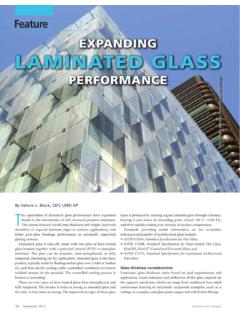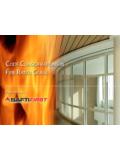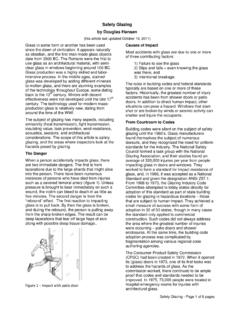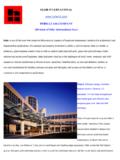Transcription of NICKEL SULPHIDE INCLUSIONS - Brital
1 I NICKEL SULPHIDE INCLUSIONS A report on the phenomena of spontaneous breakage in Fully tempered (Toughened) glass by John Reeves, Technical Manager Gulf glass Industries, Revised 25th May 2004 II PURPOSE OF THE REPORT In countless cases where a spontaneous breakage of tempered glass has been attributed to NICKEL SULPHIDE (NiS) INCLUSIONS , Architects, specifiers, building contractors and curtain walling sub-contractors often attempt to place the liability on the glass processor. glass suppliers generally do not accept responsibility for replacement whether their warranties state the limitation or otherwise. This publication shows that the wealth of information readily available on the subject makes this type of claim spurious if not vexatious and time wasting.
2 Those involved in determining glass specifications can neither claim ignorance of the spontaneous breakage phenomenon nor shun responsibility for the consequences. HEAT TREATED glass To understand the content of this publication it may first be useful to first review the following appraisal of Heat-Treated glass . This technical bulletin from GGI provides a quick overview of the differing types of glass Heat Treatment with their physical properties and varying applications. Additionally included are subject headings on; Annealed glass , as this is occasionally misunderstood to be an alternative secondary heat treatment process and; Spontaneous Breakage as this figures largely in the purpose and development of certain heat treatments. WHAT TYPES OF HEAT TREATED glass ARE AVAILABLE? 1. Fully tempered (also known as tempered or Toughened.)
3 2. Heat Strengthened 3. Heat Soak Tested Generally the first two glass types are made from Annealed float glass . Annealed float glass is ordinary glass , so called due to the nature of the manufacturing process. ANNEALED glass Annealed float glass is usually manufactured to ASTM C-1036 or BS 952. In simple terms float glass is made by pouring molten glass onto a shallow bath of molten tin. Then drawing the subsequent ribbon across the tin so that the flat surface of the liquid is duplicated on the two surfaces of the glass . As it is gently drawn from the pouring side of the tank it becomes cooler and solidifies. The glass surface condition being optically as flat as the liquid onto which it was poured. The float glass cannot be immediately taken from the float tank as the outer surfaces of the glass will cool too rapidly and set up internal unwanted tensile stresses.
4 It is therefore further processed through an Annealing kiln called a Lehr to afford controlled cooling to near external ambient temperature and thereby remove all stress within the glass . III The resultant Annealed Float glass can be further processed by cutting to size, drilling, beveling, polishing, brilliant cutting, et c. The purpose of Heat Treatment therefore is to intentionally introduce a stress regime into the glass . The most common form being tempered glass . FULLY tempered glass (ALSO KNOWN AS tempered OR TOUGHENED) What is tempered glass ? tempered glass was originally developed as a safety glass . Primarily this is still what it is specified as. How is Safety glass Classified? The classification of a safety glass is commonly expressed in international standards as one which, will either not break given a certain impact or break safely.
5 The safe breaking characteristics are usually further described as not allowing large shards of glass that could cause piercing injuries. How is tempered glass Made? tempered glass is made by heating the annealed glass to the softening temperature and then subjecting it to a rapid cooling with high-pressure air blowers. This rapid cooling affects the outer surface of the glass more quickly than the inner mid-plate and prevents it from returning to its original annealed float molecular pattern. The process therefore deliberately sets up an internal tensile and opposing external compressive stress regime. The compressive strength targeted is designed specifically to yield the following characteristics: - 4-5 times greater resistance to mechanical forces. When broken shatters into small relatively harmless dice-like fragments.
6 Why Stronger? Annealed float is very strong in compression but very weak in tension. Tempering glass induces high compressive strength on the outer surfaces of the glass . Subsequently the glass can sustain higher mechanical loading. Why Safer? If the tensile stressed inner mid-plate of the glass is compromised by a crack, the bond holding the glass together is broken and the entire panel will disintegrate into small dice. A person in contact with the glass stands little chance of sustaining a piercing injury. tempered glass Applications Areas of glazing where accidental human impact is a possibility. Glazing that carries structural loads. Glazing that is expected to withstand high wind loading. IV glass installations where thermal shock risk is present. HEAT STRENGTHENED glass What is Heat Strengthened glass ?
7 Heat Strengthened glass is glass that is stronger than annealed glass by a factor of approximately 2 to resist mechanical load, but is not a safety glass . How is Heat Strengthened glass made? The product has undergone a similar heat treatment process as tempered glass using the same plant and equipment, with two exceptions. The differences are that the heating cycles are slightly different, and rapid cooling is not with such high pressures. Why have Heat Strengthened glass ? Heat strengthened glass was developed to tackle a very specific phenomena that infrequently occurs with tempered glass . The effect of total disintegration of tempered glass when broken for no apparent reason can be dramatic when it happens. Spontaneous breakage in tempered glass , although rare, commonly arouses strong and mixed reactions from client and contractor alike.
8 Heat Strengthened glass is unlikely to suffer the phenomena and does not disintegrate in such a spectacular fashion. This is because the Heat strengthened glass breakage pattern is very similar to Annealed float glass . A further benefit to utilising Heat Strengthened glass is that the roller wave surface distortion produced in the Heat Treatment process is less pronounced than that for tempered . Heat Strengthened glass Applications Glazing that is expected to withstand high wind loading. glass installations where thermal shock risk is present. Glazing where roller wave requires minimising. Glazing where spontaneous breakage is to be avoided. HEAT SOAK TESTED glass What is Heat Soak Tested glass ? Heat Soak Tested or Heat Soaked glass is a tempered glass that has undergone additional heat treatment intended to eliminate by destruction any glass panels that have a characteristic that may latently manifest as a spontaneous breakage after installation.
9 V What is the Heat Soak Test? After tempering the glass is batched and stacked in a static oven. The temperature is held at a high enough level to induce accelerated conditioning but not so high as to affect the desired stress regime in the glass . The required conditioning is for three purposes: - 1. To increase the growth of any microscopic vents from the glass edge or surface sufficient to create a compromise of the tensile mid-plate and cause a subsequent glass breakage. 2. To increase the growth of any microscopic vents around the surface of a microscopic foreign body within the glass and thereby cause a spontaneous breakage. 3. To increase the growth rate of any NICKEL SULPHIDE INCLUSIONS setting up a chain reaction that may also cause a subsequent breakage. Heat soak testing is expected to eliminate 98% of those tempered glass panels from production that may have otherwise sustained a spontaneous breakage.
10 SPONTANEOUS BREAKAGE How Does a Spontaneous Breakage Happen? Spontaneous breakage can occur for several reasons. The most common being edge defects, caused either during processing or installation; Surface damage, caused either before or after installation leaving deep scratches or pitting and foreign bodies such as NICKEL SULPHIDE in the glass from which, vents (cracks) can initiate or grow. Why should NICKEL SULPHIDE Cause a Spontaneous Breakage? NICKEL SULPHIDE is only found in very minor quantities during a typical year of production from a float line. It has always been present in glass but can only cause the highly emotive spontaneous breakage in tempered glass . NICKEL SULPHIDE INCLUSIONS are mostly so small that they cannot be detected by any commercially viable method. Nonetheless they are capable of causing breakage by virtue of the necessity to change shape and volume in tempered glass where only a small vent is needed to cause breakage.






